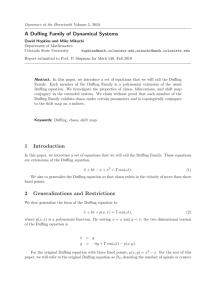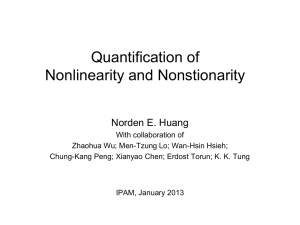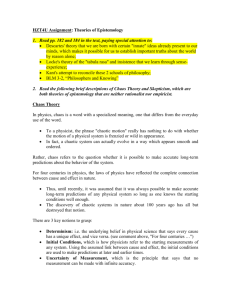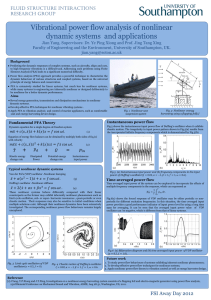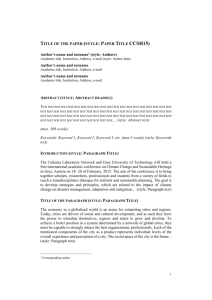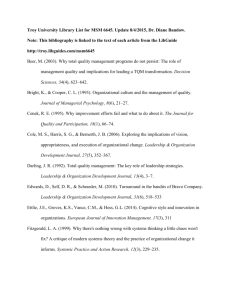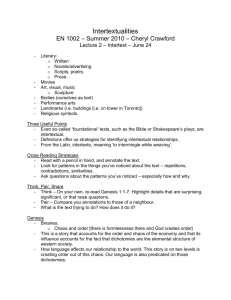The Duffing Equation: A Nonlinear Differential Equation
advertisement
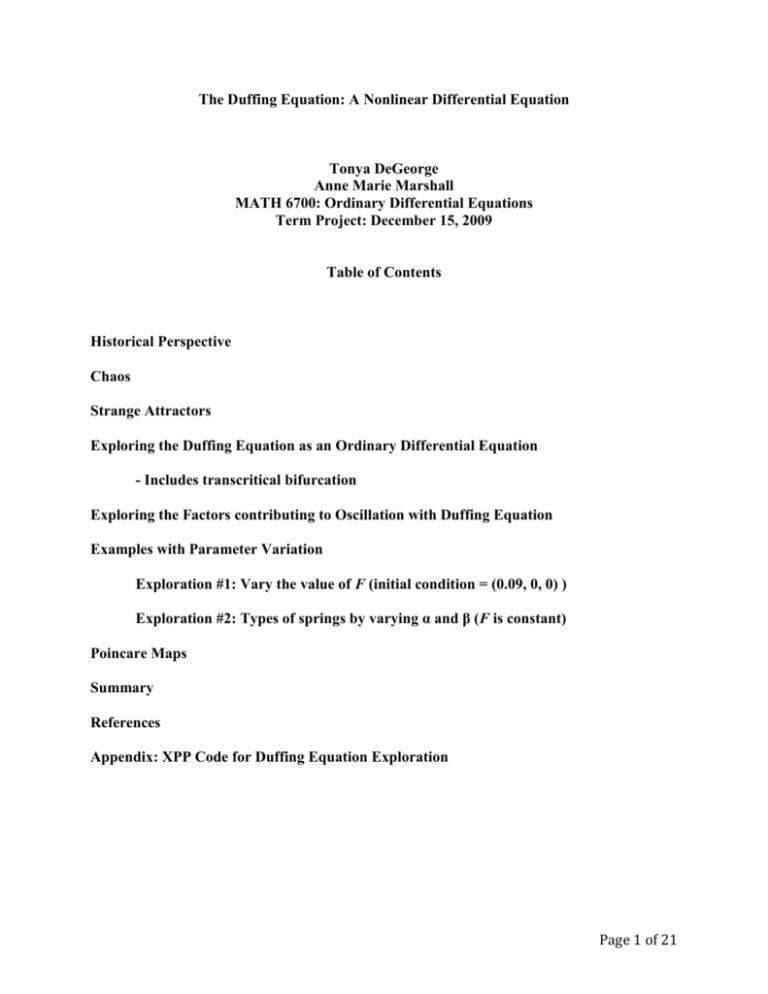
The Duffing Equation: A Nonlinear Differential Equation Tonya DeGeorge Anne Marie Marshall MATH 6700: Ordinary Differential Equations Term Project: December 15, 2009 Table of Contents Historical Perspective Chaos Strange Attractors Exploring the Duffing Equation as an Ordinary Differential Equation - Includes transcritical bifurcation Exploring the Factors contributing to Oscillation with Duffing Equation Examples with Parameter Variation Exploration #1: Vary the value of F (initial condition = (0.09, 0, 0) ) Exploration #2: Types of springs by varying α and β (F is constant) Poincare Maps Summary References Appendix: XPP Code for Duffing Equation Exploration Page 1 of 21 The Duffing Equation: A Nonlinear Differential Equation Historical Perspective The Duffing Equation, named after the German electrical engineer Georg Duffing in 1918, has been widely used in physics, economics, engineering, and many other physical phenomena. Given its characteristic of oscillation and chaotic nature, many scientists are inspired by this nonlinear differential equation given its nature to replicate similar dynamics in our natural world. This equation, together with Van der Pol’s equation, has become one of the most common examples of nonlinear oscillation in textbooks and research articles. (Sheu, Chen, Chen & Tam, 2005, Korsch, Jodl & Hartmann, 2008) The Duffing equation typically refers to the Duffing oscillator. A common model using this oscillator involves an electro-magnetized vibrating beam analyzed as exhibiting cusp catastrophic behavior for certain parameter values. (Zeeman as cited in Rosser, 1991, p. 21). The Duffing oscillator, which is normally written as x x x x 3 F cos t , (Equation 1) is a simple model that can show different types of oscillations such as chaos and limit cycles. The terms associated with this system represent: x x : simple harmonic oscillator with frequency x: small damping x : small nonlinearity F cos t : small periodic forcing term with frequency 3 The physical model (Figure 1) depicting the Duffing oscillator involves two magnets that deflect a steel beam toward each other, as shown below. Figure 1 Page 2 of 21 This is a forced oscillator with a nonlinear spring with a restoring force of F x x 3 . Different values of can create either a hardening spring (where > 0) or a softening spring (where < 0). Different values of can also change the dynamics of the system. For values of less than zero, the Duffing oscillator displays chaotic motion creating a double well potential when the two magnets deflect the beam back and forth from each other which is graphically presented below (Figure 8.1). It is in this state of movement where the beam has enough energy to swing completely across to each magnet. Another scenario occurs when the beam oscillates strictly in one hemisphere (right or left) between one magnet and the center position. Researchers offer speculation on the chaotic attributes of this oscillator as being the reason so many applications have drawn to reference this equation. Specifically, Holmes (1979 as cited in Rosser, p. 21) established the significance of how the variance of a single crucial parameter residing in the Duffing Equation can lead to a connection with the sequence of perioddoubling bifurcations. Other researchers, such as Ueda, studied the associated complexities of this equation about the nature of strange attractors. Further variation in the Duffing oscillator formula is seen in that of Puu (p. 65) as he describes the Duffing Forced Oscillator in a similar fashion as stated below: xx 1 3 x cos t 6 Many simulation studies use the Duffing Equation in search of patterns that can be identified with specific parameter settings. Puu (2000) shows four periodic attractors that present themselves in mirror images of each other. This symmetric characteristic of the Duffing Equation, with specific parameter settings, is described as, “if we reverse the signs of all the variables, then the system is not changed. Such symmetry implies that attractors are either themselves, or, if they are not, they come in pairs so as to make up the symmetry together.” (p. 70) Chaos As is typical in the world of scientific discovery, the first discovery of a significant concept is not realized immediately. Such is the case with the concept of chaos as a visual Page 3 of 21 descriptive tool in the field of physics. From 1875 to 1925, Henri Poincare, Pierre Fatou, and Gaston Julia, all French mathematicians, have been credited with using chaos in their own studies. It was not until 1961 when Edward Lorenz, a theoretical meteorologist at the Massachusetts Institute of Technology (MIT) discovered the significant impacts on a weather model’s behavior when he applied small changes to initial conditions at the midway stage. Further breakthroughs occurred in that same timeframe with chaotic attractors when Yoshisuke Udea discovered how chaos exists everywhere in the natural world. (Kim, 1998) The Duffing equation is routinely associated with mathematical chaotic behavior. According to Strogatz (1994), chaos is “aperiodic long-term behavior in a deterministic system that exhibits sensitive dependence on initial conditions.” Although there is no set definition of chaos, mathematicians agree that there are three properties that must exist in a dynamical system in order to be classified as chaotic: It must have aperiodic long-term behavior meaning that the solution of the system settles into an irregular pattern as t . The solution does not repeat or oscillate in a periodic manner. It is sensitive to initial conditions. This means that any small change in the initial condition can change the trajectory, which may give a significantly different long-term behavior. It must be “deterministic” which means that the irregular behavior of the system is due to the nonlinearity of the system, rather than outside forces. (p.323-324) The challenge with chaotic systems, as described by Puu (2000), is “that computation errors are progressively increased without bounds. As the…uncertainty eventually becomes as large as the whole extension of this attractor,… remedies relying on increased precision in stating the initial conditions are not practical, because the rate of error is exponential.” (p. 78). Strange Attractors As mentioned earlier, Ueda identified and explored the Duffing equation as it related to strange attractors, specifically with models in economics. Strogatz (1994) defines an attractor as “a set to which all neighboring trajectories converge. Stable fixed points and stable limit cycles are examples.” (p. 324) Strogatz further defines a strange attractor as “exhibit[ing] sensitive dependence on initial conditions.” (p 325) In Figure 8.2, Ueda pictorially presents the Duffing equation with respect to how periodic and/or chaotic attractors vary by region. This diagram presents the complex nature of what appears to be a simple system by showing the numerous behaviors described qualitatively by region. (p. 160) Udea (2008 as cited by Korsch, et. al.) states that this “map is not complete and many details have to be filled in.” Page 4 of 21 Exploring the Duffing Equation as an Ordinary Differential Equation There are many ways to explore the Duffing Equation, each depending on what values are assigned to the various parameters. For this exploration, the unforced case (F = 0) with α = β = 1, presented by Wiggens (1990, as cited in Weisstein) is presented for an analytical review. x x x x 3 F cos t (Minus sign applied, adapted from Equation 1) xy y x x3 y The first step in this analysis is to identify and classify all fixed points. x0y y 0 x x3 y From here, we determine that y 0 0 x x 3 x 1 x 2 x 1 x 1 x Page 5 of 21 Thus, generating 3 fixed points: (0, 0), (1, 0), and (-1, 0) as represented in Figure 2. At this point, we linearize the equations by differentiating them as such: x x3 y xy y x 3x 2 x y 1 3 x 2 x y Now, we will explore the characteristic polynomial of each fixed point by using the generalized form of the characteristic equation to classify stability. Figure 2 2 0 where 1,2 1 4 , 2 12, generalized 1 2 Fixed Point = (0, 0) 0 1 1 1 2 1 0 Characteristic Equation By equating the characteristic polynomial with the generalized form with the fixed point: (0, 0) values, the results in and 1 . Thus, the classification of this fixed point is restricted to an Unstable Saddle point due to 1 Thus, (0, 0) is Unstable Saddle Page 6 of 21 Fixed Points = (±1, 0) 0 2 1 2 2 2 0 Characteristic Equation Similar to the preceding classification, this pair of fixed points, (±1, 0) is evaluated by equating the characteristic equations that yield and 2 Unlike the prior scenario, the fact that 2 , offers some variety in classification which is associated with the value of that are explored in three different cases. 0 0 Case (i) 2 Thus, the classification of this pair of fixed points is Stable given 0 and 0 . The pair of fixed points (±1, 0) are both Stable Case (ii) 0 0 2 Thus, the classification of this pair of fixed points is Neutrally Stable Center given 0 and 0 . The pair of fixed points (±1, 0) are both Neutrally Stable Centers Case (iii) 0 0 2 Thus, the classification of this pair of fixed points is Unstable given 0 and 0 . The pair of fixed points (±1, 0) are both Unstable It is here were we have uncovered a Transcritical Bifurcation that hinges on the damping parameter, . This is supported algebraically in this version of the Duffing Equation (with no force, F = 0) where two of the three fixed points change from being stable to unstable, dependent on the direction of damping. In particular, when the damping is positive ( > 0), the system follows a spiraling path that oscillates to stability. Conversely, when the damping is negative ( < 0), the system spirals, in a oscillating fashion, off to infinity as a result of the two unstable fixed points. Page 7 of 21 This bifurcation can be graphically evidenced in the following diagrams an XPP graph of this ODE has been designed to show that the damping parameter, , (defined as the variable = d) is varied as Positive (Figures 3A/B), Zero (Figures 4A/B), and Negative (Figures 5A/B). Case (i) d = +1 ( > 0 ) Figure 3A Figure 3B: The fixed points (±1, 0) have both been classified as Stable. Page 8 of 21 Case (ii) d = 0 Figure 4A Figure 4B:The fixed points (±1, 0) have both been classified as Neutrally Stable. Page 9 of 21 Case (iii) d = -1 ( < 0 ) Figure 5A Figure 5B: The fixed points (±1, 0) have both been classified as Unstable. Exploring the Factors contributing to Oscillation with the Duffing Equation One of the most significant features of the Duffing Equation is its oscillation, hence its alternate label, Duffing Oscillator. As presented thus far, this oscillation is resident in the system’s behavior even without (F = 0) the inclusion of the cyclic influence of the trigonometric function, cosine. It is at this point in our exploration of the Duffing Equation where we graphically explore the Duffing Equation with a variety of forcing parameter values. x x x x 3 F cos t Each pair of phase plots represents a 3-dimensional system. The left hand offers the x vs. y view and the right hand side offers the x vs. z view. Each graph contains evidence of Chaos and Oscillation. This first set of three graphics (Figures 6A/B, 7A/B, 8A/B) have Page 10 of 21 been designed to explore system impacts with variance strictly applied to the Force (F = 0.1, 0.5, and 1.0), there is no damping (δ = 0), and both the harmonic and spring stiffness parameters are set equal to each other (α = β = 1), Figure 6A and 6B: (F = 0.1, =1, =1, = 0), Variance on Force, No Damping Figure 7A and 7B: (F = 0.5, =1, =1, = 0), Variance on Force, No Damping Page 11 of 21 Figure 8A and 8B: (F = 1.0, =1, =1, = 0), Variance on Force, No Damping Although there appears to be a unique set of data associated with each varied set of Forces (F = 0.1, F = 0.5, and F = 1.0), the overall qualitative nature remains relatively similar. Each system presents a set of trajectories traversing as a double well that oscillates in somewhat bounded and random way (chaos). This type of generalized behavior is similar to the original exploration findings of the Duffing Equation that involved no force (F = 0). Upon further investigation, a particular F-value offered a quite distinctive pattern inconsistent with the others. Specifically, F = 55 in Figure 10A & 10B illustrates a highly structured set of trajectories in its graphical presentation. Unlike other systems with Fvalues relative close to this one (Figures 9A/B: F = 50 and Figures 11A/B: F = 60), this particular system (F = 55) appears to have a less visible random set of trajectories. Additionally, this system displays a bi-level distribution where the trajectories congregate at the top of one well and the bottom of the other; they are not evenly disbursed as the other diagrams display. With further exploration of random samples of F-values between 70 and 100, no other unique patterns were detected causing a speculation that the F = 55 potentially has some algebraic significance. Page 12 of 21 Figure 9A and 9B: (F = 50, =1, =1, = 0), Variance on Force, No Damping Figure 10A and 10B: (F = 55, =1, =1, = 0), Variance on Force, No Damping Page 13 of 21 Figure 11A and 11B: (F = 60, =1, =1, = 0), Variance on Force, No Damping Examples with Parameter Variation Zhang (2005) explores the Duffing Equation for a variety of spring types. (p. 84) This system is rewritten as three coupled first-order ordinary differential equations: xy y 2 y x x 3 F cos z (Equation Set 1) z 1 where 1, 1, 0.25, x 0 0.09, x 0 0, F 0.34875 x t F displacement from equilibrium harmonic behavior spring stiffness Force amplitude dampening coefficient driving frequency The remainder of this paper is dedicated to an investigation of these parameters and what impact they have on the behavior of the Duffing equation. This investigation took two different paths; the first effort focused on exploring the impact of two different values of F, as specified by Zhang. The second examines the different classifications of springs that involve variation with both the α and β parameters. Page 14 of 21 Exploration #1: Vary the value of F (initial condition = (0.09, 0, 0) By experimenting with the value of F (the forcing constant), we can see in Figure 12A and 12B the system behavior exhibited in two different planes. For example, given an F-value of 0.34875, as shown below, we can see that the system is periodic. In other words, the beam is moving at a constant pace between the two magnets (the polarity of the magnets is about equal). By looking at the (x, y) plane in Figure12A, we can see that the beam follows a similar path as it moves between the two magnets. The (x, z) plane as presented in Figure 12B offers a different view demonstrating “a period-two solution as the pattern repeats every two oscillations when steady-state is achieved.” (Zhang, 2000, p. 84) Figure 12A and 12B (F = 0.34875) However, with a higher F-value, as presented in Figure 13A and 13B, the system moves into a state of chaos, where the beam is moving randomly between the two magnets. Since the polarity of the magnets is not equal, the magnets are competing with each other. The beam will move toward one magnet for some time until it reaches a position where the attraction to the other magnet becomes too great and will therefore move to the other magnet. Although the beam is moving between the two magnets, it is hard to tell when the beam will move to the opposite magnet. In addition, the beam will always be attracted to or repelled between the two magnets. Even though the path may be chaotic, the area of its path is predictable. Figure 13B displays this behavior in the (x, z) plane as there are two areas in which the beam will spend some time and revolve around before crossing over to the other magnet. Hence, the motion is random and chaotic but the paths will remain in the same general area (bouncing back and forth between the two magnets). It, therefore, seems like the chaotic behavior is bounded within a certain region. Page 15 of 21 Figure 13A and 13B (F = 0.43) Exploration #2: Types of springs by varying α and β (F is constant) This exploration focuses on various characteristics of the Duffing Equation, as presented by Zhang (2005) for a forced spring equation. (p. 83) Figure 14 Here the Duffing equation offers insights on the mechanical aspects of the spring. By experimenting with the values of and in Equation Set 1, we can explore the various types of springs (hard, soft, harmonic, inverted) by keeping the value of F constant. The Duffing equation is further classified (Zhang, 2005) according to the signs and values of the parameters of α and β. (p.84) Type of Duffing Equation Hard spring Soft spring Non-Harmonic Inverted α >0 >0 =0 <0 β >0 <0 >0 >0 Page 16 of 21 Figure 15 presents a hard spring where and are both greater than zero. A hard spring is stiffer than a soft spring; when a mass is pulled from a hard spring; its shape is restored more quickly than a soft spring and will then oscillate until it reaches its equilibrium. This behavior is evident in the picture below as the spring achieves periodic motion quickly. The “tightness” of the path below demonstrates the oscillation of the spring, which is relatively close to its equilibrium point. Hard Spring: Figure 15 F = 0.34875, α = 1 (> 0); β = 1 (> 0) Figure 16 represents the restoration of a soft spring. Given its low spring constant value (i.e. low stiffness), it will have difficulty restoring to its initial coiled state. Soft Spring: Figure 16 F = 0.34875, α = 1 (> 0); β = -1 (< 0) A simple harmonic oscillator occurs when the path of the spring moves at a constant frequency and amplitude around its equilibrium point. If the harmonic oscillator is damped, it is characterized with a decreasing frequency and amplitude over time. Conversely, as presented in Figure 17, this spring is non-harmonic (α = 0), displaying a lack of balance with respect to the equilibrium point. Page 17 of 21 Figure 17 Non-Harmonic: F = 0.34875, α = 0; β = 1 (> 0) Figure 18 presents the system behavior of an inverted spring where its parameters are the opposite of those of a soft spring. The initial condition of (0.09, 0, 0) is embedded in the bounded steady-state path where it is repeatedly revisited. This is different from the other spring type behaviors where the initial condition is encircled by a bounded path. Inverted: Figure 18 F = 0.34875, α = -1 (< 0); β = 1 (> 0) Poincare Maps When a system demonstrates chaotic behavior, it is often difficult to analyze, thus, many mathematicians have used Poincare maps to study the global movement in a dynamical system. Strogatz (1994) describes a Poincare map as a specific type of diagram that captures the path of a particle in its orbit. Specifically, the map records a dot representing the point in time when a Page 18 of 21 trajectory completes each cycle. A Poincare map tracks all these “dots” to create a picture to monitor the overall behaviors and flow of the system. (p. 278) The Duffing equation continues to mystify mathematicians and scientists with its complex variance in behavior. Dr. Yoshisuke Ueda, a Japanese engineer, modified the Duffing equation upon discovering chaos in his model. The system behavior of his version of the Duffing equation is presented below in a series of Poincare maps (Figure 19) where the attractor presents characteristics of being bounded and chaotic. Figure 19: Poincare maps of Ueda Attractor Summary In summary, the Duffing equation (or oscillator) can take on many forms depending on the choice of parameters. In spite of this variety, the oscillating feature is consistent in all cases, whether generated with or without a trigonometric Force component. This system can be designed to generate trajectories presenting a transcritical bifurcation as well as chaotic behavior. The Duffing Equation has been used in the fields of engineering, economic, physics, population growth, and genetics, to name a few. The authors of this paper found this topic to be both challenging and enlightening through an exploration of how different parameters influence the overall nature of a system. Given its balance of both complexity and generally similar globalized, qualitative nature, future research will most likely ensued in search of the discovery of new and exciting applications. References: Page 19 of 21 Inagaki, K. (2003, April 28). Yoshisuke Ueda Discovered Chaos in Nature in 1961. Paper submitted for award consideration. Retrieved November 24, 2009, from http://inagaki.ist.i.kyoto-u.ac.jp/YoshisukeUedaDiscoverdChaosInNature1961.html Kim, J. B. (1998, April). Analysis of Discovery of Chaos: Social and Cognitive Aspects. Paper presented at the Annual meeting of the American Educational Research Association, San Diego, CA. Korsch, H, J. Jodl, H.J., & Hartmann, T. (2008). Chaos: A Program Collection for the PC (3rd ed.). Spring-Verlag: Berlin Heidelberg, Germany. Puu, T. (2000). Attractors, Bifurations & Chaos: Nonlinear Phenomena in Economics. SpringVerlag: Berlin Heidelberg, Germany. Rossler, J. B. (1991). From Catastrophe to Chaos: A General Theory of Economic Discontinuities. Kluwer Academic Publishers: Norwell, MA. Shu, L.J., Chen, H. K., Chen, J. H., & Tam, L. M. (2007). Chaotic dynamics of the fractionally damped duffing equation. Chaos, Solutions and Fractals, 32, 1459-1468. (Elsevier Ltd., doi:10.1016/j.chaos.2005.11.066) Strogatz, S. H. (1994). Nonlinear Dynamics and Chaos. Perseus Books Publishing: Cambridge, MA. Ueda, Y. (1979) Randomly transitional phenomena in the system governed by duffing’s equation, Journal of Statistical Physics, 20(2), 181-196. Retrieved November 5, 2009, from http://wb.olin.edu/complex/India08/dynamics/Ueda/notes_ueda.pdf Weisstein, E. W. (2009). MathWorld: Duffing Differential Equation. Retrieved on November 11, 2009, from http://mathworld.wolfram.com/DuffingDifferentialEquation.html Zeeman, E. C. (2000, March 31). Duffing Equation: Catastrophic Jumps of Amplitude and Phase. Lecture presented at Trinity University. Retrieved November 15, 2009, from http://zakuski.math.utsa.edu/~gokhman/ecz/duffing.html Zhang, W.B. (2005). Differential Equations, Bifurcations, and Chaos in Economics. World Scientific Publishing: Hackensack, NJ. Appendix: XPP Code for exploration of Duffing Equation Page 20 of 21 Page 21 of 21
